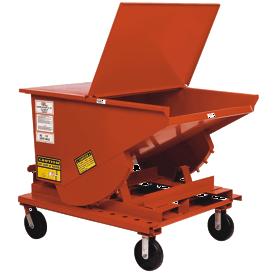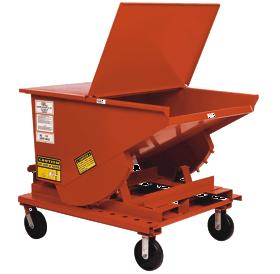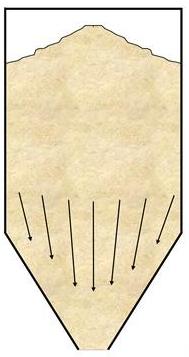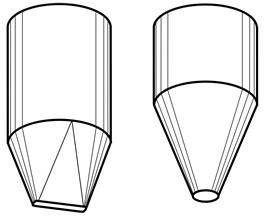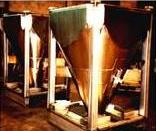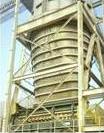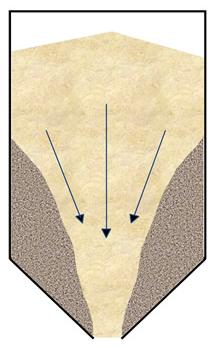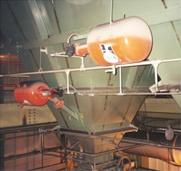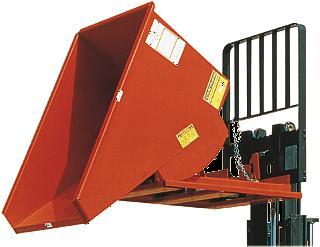Hoppers are used primarily in materials handling as storage vessels, transporters, and feeders. The sections below describe different type of hoppers. Sections for these sub-types of hoppers include general information, equipment design, usage examples, and advantages/disadvantages.
Mass Flow
General Information/Equipment Design
In a mass flow hopper, all the material inside the hopper moves down the walls and exits. The flow is based upon a first-in, first-out principle and is uniform and reliable upon discharge. Moisture content, temperature, age, oil content, and solid levels must be regulated to ensure effective flow.
There are two types of hoppers, conical and wedge-shaped. The hopper shown below to the right is conical whereas a wedge-shaped hopper is a trough with a narrow slit, as shown to the left. Conical hoppers must be steeper to promote the same amount of flow but wedge-shaped hoppers require a conveyer to collect the materials that exit from them.
The video shown below shows how materials flow through a mass flow hopper. As mentioned, all the material in the hopper moves uniformly.
Usage Examples
Mass flow hoppers are used in virtually every type of industry and come in a variety of sizes. Hoppers are most often used for raw material and product storage as well as feeders for different processes.
Advantages
- Flow will not cake or spoil.
- Controlled segregation.
Disadvantages
- Possible blockage.
Funnel Flow
General Information/Equipment Design
In funnel flow, the material along the funnel walls remains stationary, while the material in the center falls through the outlet creating a rat hole, or channel. Funnel flow hoppers have a greater angle from the center of the cone as shown below.
The video below shows funnel flow. As shown in the diagram above, material flows through a center channel. The funnel in the movie below is shaken to prevent a build-up of particles on the funnel sides.

Usage Examples
Funnel flow is versatile and can be used in many of the same applications as mass flow. A funnel flow design is most effective when the solid particulate is coarse, free-flowing and not prone to caking. Also, funnel flow is used when segregation is not important.
Advantages
- Well-known technology.
- Less expensive than mass flow.
Disadvantages
- Segregation spoilage and caking occur.
- Bridging occurs, preventing constant flow.
Self-Dumping
General Information/Equipment Design
Self-dumping hoppers are designed so they can be easily moved manually or by forklift. They are used for transportation as well as storage. For space conservation, self-dumping hoppers are stackable. The hopper pictured below would typically be loaded by a conveyor. The material would then be safely stored and transported. When material is to be unloaded, the hopper latch unlocks, tipping the hopper forward and dumping the entire load. After successfully dumping the load, the hopper returns to an upright position and locks.
Usage Examples
Self-dumping hoppers are used in most industries. They are usually used to store and transport ashes, wood, glass, aluminum, metals, powders, and finished products such as fertilizers, cereals, and detergents. Below is a forklift lifting a hopper, showing its self-dumping mechanism.
Acknowledgements
- Bulk Process Equipment, Inc., Baltimore, MD
- DC Graves Co. Inc., Wakefield, MA
- Jenike & Johanson, Inc., Tyngsboro, MA
References
- Carson, John W. and Joseph Marinelli. “Bulk Solids To Ensure Smooth Flow” Chemical Engineering April 1994: 78-86.
- Drescher, A. “On the Criteria For Mass Flow Hoppers.” Powder Technology 95 (Dec. 15, 1992): 143-151.
- Langston, PA., U. Tuzun, and D.M. Hayes. “Continuous Potential Discrete Particle Simulations of Stress and Velocity Fields in Hoppers: Transition From Fluid to Granular Flow.” Chemical Engineering Science, 49 (April 1994): 1259-1275.
- Marinelli, Joseph. “A Practical Approach To Bins and Feeders.” Chemical Engineering. 7 (2002): 39-42.
- Perry, Robert H., and Don W. Green. Perry’s Chemical Engineers’ Handbook. 7th ed. New York: McGraw-Hill, 1997: 21-27. Print.
- Purutyan, Herman, Brian H. Pittenger, and John W. Carson. “Solve Solids Handling Problems by Retrofitting.” Chemical Engineering Progress, April 1998: 27-39.
Developers
- Julie Messacar
- Keith Minbiole

